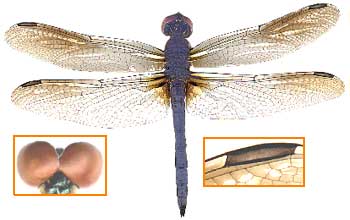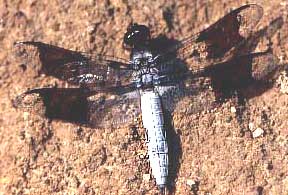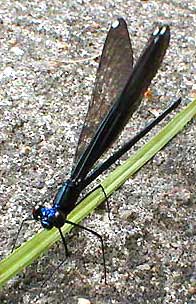


English Name: Yellow-sided Skimmer
Family: Libellulidae (common skimmers)
Genus: Libellula
Species: flavida
If you live near a body of water where dragonflies congregate and you have some binoculars, you can have oodles of fun by getting the book called Dragonflies Through Binoculars: A Field Guide to Dragonflies of North America, and listing all the dragonflies in your area. You'll be amazed by how many species you can spot, how different from one another they are, and what fascinating habits they have! To give you an idea of what dragonfly identification is like, the two inset images shown above with the skimmer are close-ups showing features that help determine which species we have. Those orangish things at the lower left are the skimmer's compound eyes. Notice how they join together at their bases. If this had been a grayback or clubtail dragonfly, the eyes wouldn't have joined. At the lower right you see a close-up of the veins at the very top, right of the dragonfly's top, right wing. Here the important thing to see is that there is no "brace vein" at the bottom, left of the conspicuous dark rectangle, cutting across the patch of wing just below the rectangle. If it did have such a vein, it could have been a darner.
 English Name: Common Whitetail
English Name: Common Whitetail
Family: Libellulidae (common skimmers)
Genus: Libellula
Species: lydia
Common Whitetails are among the most abundant and widespread of our dragonflies, found throughout nearly all of the US and southernmost Canada and northernmost Mexico. Two reasons this species is so common are that they are strong, aggressive fliers, and their aquatic larvae are fairly tolerant of low oxygen in the water, and organic pollution. As suggested by the photo, adults are attracted to the brown color of mud. It's fun to watch this species darting about defending its territory of 20-180 square yards. When one Common Whitetail wishes to communicate to another that it should leave the territory or else, it raises its abdomen as a threat display. Males wishing to reply that they mean no harm and regard themselves as submissive, lower their abdomens.
 English Name:Ebony Jewelwing
English Name:Ebony Jewelwing
Family: Calopterygidae (broad-winged damselflies)
Genus: Calopteryx
Species: maculata (female)
Here are the most obvious differences between dragonflies and damselflies: